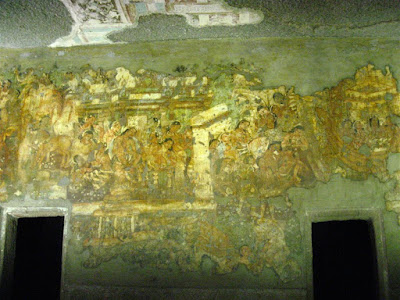Ajanta caves
Although we had planned to leave at 07:00 from the MTDC complex in Aurangabad for Ajanta Caves, we were only able to leave around 08:30 due to their good restaurant service. It took us two and a half hours to travel the 105 kilometers to Ajanta. Roads and signs were pretty good. Four kilometers from the caves, there is a huge parking lot where all the cars have to park. From there, the authorities should use ecological buses. The shuttle service costs Rs 7 each way for non-air-conditioned buses and Rs 15 for return air-conditioned buses.
 The distance between the parking lot and the bus bay is lined with stalls selling souvenirs, snacks, and bottled water. There is also an MTDC restaurant at the base of the caves right after you buy your entrance tickets. As the use of flash for photography is prohibited in the caves, they have installed fiber optic lights that will turn on for you after you present the 5 rubles/ticket that you have to buy at the exit. . The caves are named after a town called Ajanta. Apparently these caves were discovered in 1819 by an army officer from the Madras Regiment of the British Army during one of his hunting expeditions. at the door of each cave (20/- and 50/-) or all caves for 300/ who will do the work of each cave. All prices are negotiable.
The distance between the parking lot and the bus bay is lined with stalls selling souvenirs, snacks, and bottled water. There is also an MTDC restaurant at the base of the caves right after you buy your entrance tickets. As the use of flash for photography is prohibited in the caves, they have installed fiber optic lights that will turn on for you after you present the 5 rubles/ticket that you have to buy at the exit. . The caves are named after a town called Ajanta. Apparently these caves were discovered in 1819 by an army officer from the Madras Regiment of the British Army during one of his hunting expeditions. at the door of each cave (20/- and 50/-) or all caves for 300/ who will do the work of each cave. All prices are negotiable. 
Famous for their wall paintings, the caves are the best preserved examples of Indian art, especially painting. (2nd century BC to 6th century BC) were excavated in a horseshoe shape, facing a narrow stream known as Vagora, and each cave was connected to the stream by a stairway, now all but obliterated.

A total of 30 rock excavations were carried out, one of which is incomplete. The first excavations belong to the Hinayana phase of Buddhism. These caves date back to the Christian era, with the oldest dating back to the 2nd century BC. being a cave from the 10th century.

The cult object is a stupa, and these caves show an imitation of wooden construction, since the beams and logs are also carved, although not functional.
The world famous Ajanta paintings are divided into two main phases. The oldest, cave no. 9 and 10, KaII. They belong to the second phase of painting before Christ. in the 5th-6th centuries. It started around the turn of the century and continued for the next two centuries. These exemplary Wakataka period paintings from cave no. The main theme of paintings 1, 2, 16 and 17 is the depiction of various Yataka stories, various incidents related to the life of the Buddha, as well as current events and social life.

Ceiling decoration always consists of decorative patterns, both geometric and floral. The photographs were taken after careful preparation of the rock surface by cutting the strips so that the applied layer would be effectively preserved. The main binder used here was glue. These photos are not fresh because they are stained with binder; The murals, on the other hand, are painted when the lime is still wet and acts as a natural binder. It took us around three hours to explore Ajanta, so when we got back to the car park, we settled on hot Puri Bhaaji and Aloo Parathas at one of the 'fast food stalls'.
0 Response to "Ajanta caves"
Post a Comment